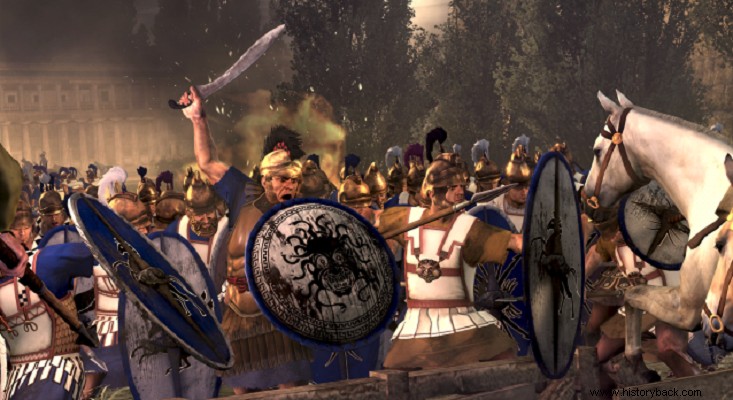
Some people are destined to shine as shooting stars for a while and then fade into the mists of history. This also happened with Onomarchus, the great general of the Phocaeans, who managed, twice, to defeat Philip II of Macedonia and his invincible Macedonian phalanxes.
Third Holy War
In 356 BC Greece once again found itself in flames as the so-called Third Holy War broke out . This war had its roots in the rivalry between Thebans and Phocaeans, with the former eventually reporting the latter to the Amphictyonic council, which imposed a heavy fine.
Unable to pay the fine, the Phocians were persuaded by general Philomelos that the only solution was to capture Delphi and fight. That's what they did. They also allied themselves with the Spartans, the Athenians and the tyrant of the Pherae and fortified the sanctuary of Delphi.
In a battle near Tithorea, however, Philomilos was killed. His brother Onomarchus commanded a division of the army in the said battle. After his brother's death he took over the leadership himself. Onomarchus proved to be more dynamic than his brother. Knowing that the opponents were not going to show mercy, he decided to cross the line.
The titular chief
He "borrowed" the treasures of the Delphic sanctuary and with the money formed a powerful army by recruiting experienced mercenaries. He created the first, in mainland Greece, a strong corps of "artillery", recruiting craftsmen and men trained in the use of catapults. He also bribed the Thessalians to leave the opposing coalition.
In 353 BC Onomachus invaded Locris and captured Thronio and then Amfissa and plundered the lands of the Doric Tetrapolis, in the area of today's Gravia. He then attacked the Boeotians, capturing Orchomenos and laying siege to Chaeronia. However, he did not occupy this city as the tyrant of the Lycofras, who was being pressured by Philip II of Macedonia, asked for his help.
This was perhaps the fatal mistake of Onomarchus as he thus brought the mighty kingdom of the Greeks of the North into the camp of his opponents. Onomachus sent his brother Phyllus to Thessaly with 7,000 men to reinforce Lycophron. But he was defeated by the Macedonians.
Victory against the Macedonians
So Onomarchus decided to campaign against Philip himself. Onomachus in 353 BC. moved towards Thessaly at the head of 20,000 infantry, 1,000 cavalry and many catapults. There is no information about the composition of his army or the type of catapults he used. They were probably light gastrfetes and spearmen.
Equipped with these innovative weapons for the timehe managed to defeat the Macedonians in two consecutive battles (2nd and 3rd Battle of Pelasgiotida, probably near Feres) . His catapults were the weapon that gave him victory against the otherwise invincible phalanxes of the sarissaphoros. His own army apparently included hoplites and peltasts. Apparently the phalangites in dense formation were reaped by the arrows of the catapults in pairs.
Philip retired humiliated and Onomarchus with these victories became famous throughout Greece . However, he did not take advantage of his victories and returned to Boeotia where he conquered Koronia. However, Philip soon returned having secured the help of the Thessalians and their famous cavalry. Onomarchus hastened to meet him on the field of fate.
Krokion Pedion 352 BC
The catalytic battle was fought in the so-called Crocion Field. Onomarchus waited for reinforcements to arrive from Athens and his Thessalian allies, but they never arrived. Thus he was faced with only his own forces against those of Philip. This time Philip had learned his lesson and instead of attacking en masse he threw into the battle his numerically and qualitatively superior cavalry.
Both opposing armies had 20,000 infantry, but Philip had 3,000 elite cavalry to Onomarchus's mere 500 . Fatefully the Phocaean cavalry was defeated and the Macedonians flanked their opponents by crushing them. The battle took place near Almyros. The Athenians, under their general Charis, hastened with the ships to join the Phocians.
But when they reached the battlefield everything was over and they themselves mixed with the fugitives of Onomarchus's army and panicked they allowed to board their ships again with heavy losses.
As for Onomarchos's army, it was disbanded. At least 6,000 men fell on the battlefield and another 3,000 were captured. The fate of Onomarchos is not clear. It is certain that he was killed, but ancient historians disagreed about the manner. Eusebius states that Onomarchus drowned trying to reach the Athenian ships.
But Diodorus Sikeliotis mentions that he was captured by Philip who killed him. The traveler Pausanias reports that he was killed by his own men and that Philip crucified his corpse, while drowning the 3,000 prisoners as they were considered sacrilege . In any case the Phocaeans continued the war until 346 BC. whereupon they were forced to lay down their arms, since they were also abandoned by their Athenian allies.
Philip especially celebrated his victory at Krokion Pedion which coincided with the birth of his daughter Thessalonica …
